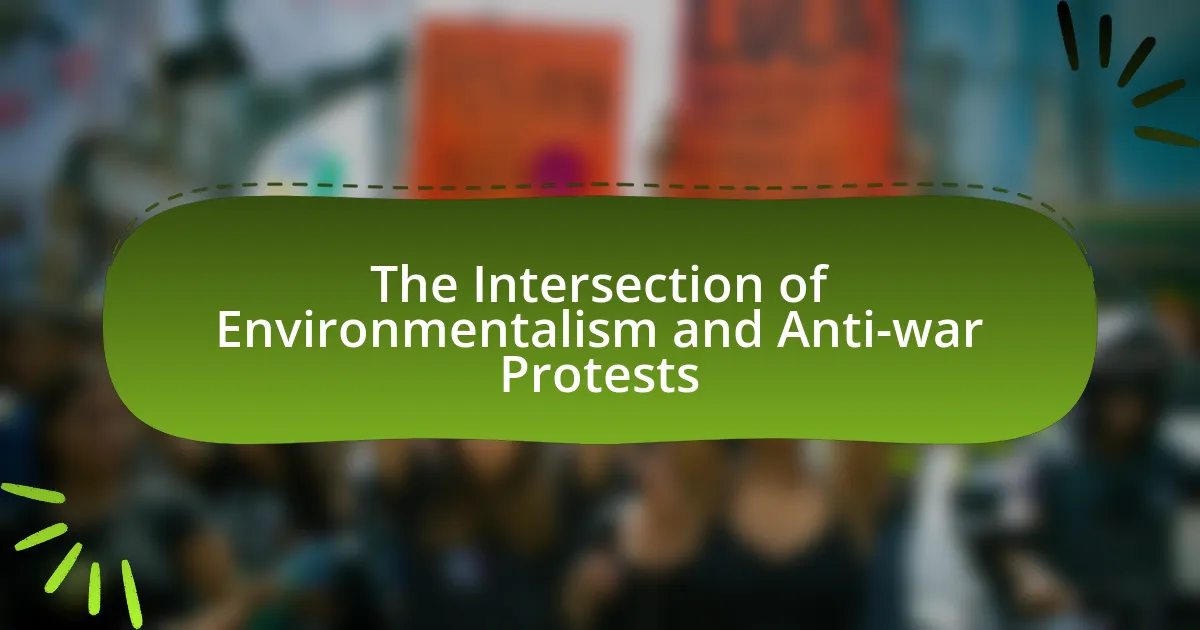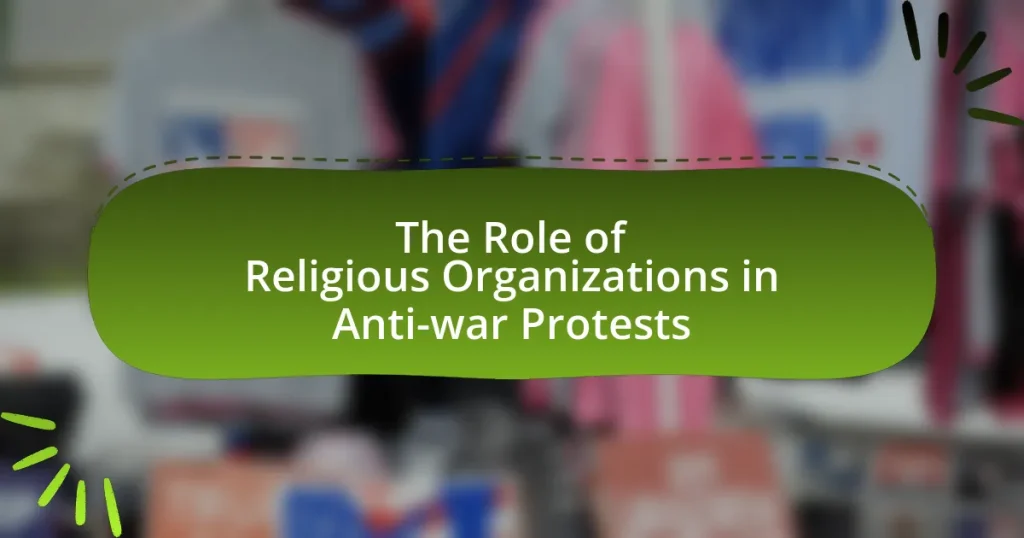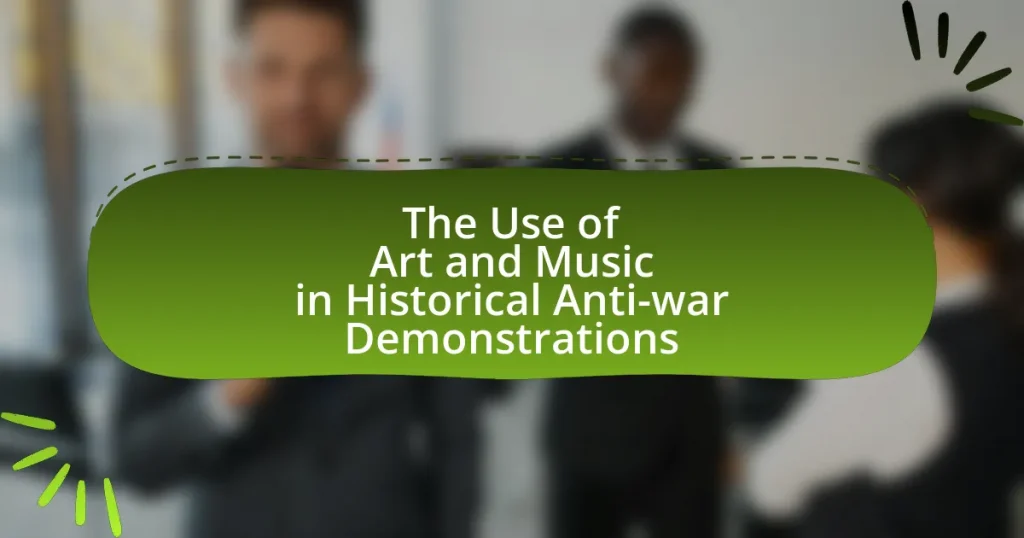The article examines the intersection of environmentalism and anti-war protests, highlighting their shared advocacy for peace and sustainability. It discusses how military actions contribute to environmental degradation, including pollution and habitat destruction, and provides historical examples such as the Vietnam War. The article also explores the collaboration between activists from both movements, the significance of their combined efforts in raising public awareness, and the challenges they face. Additionally, it addresses the impact of climate change on anti-war narratives and emphasizes the importance of uniting these causes to promote a holistic approach to social and environmental justice.
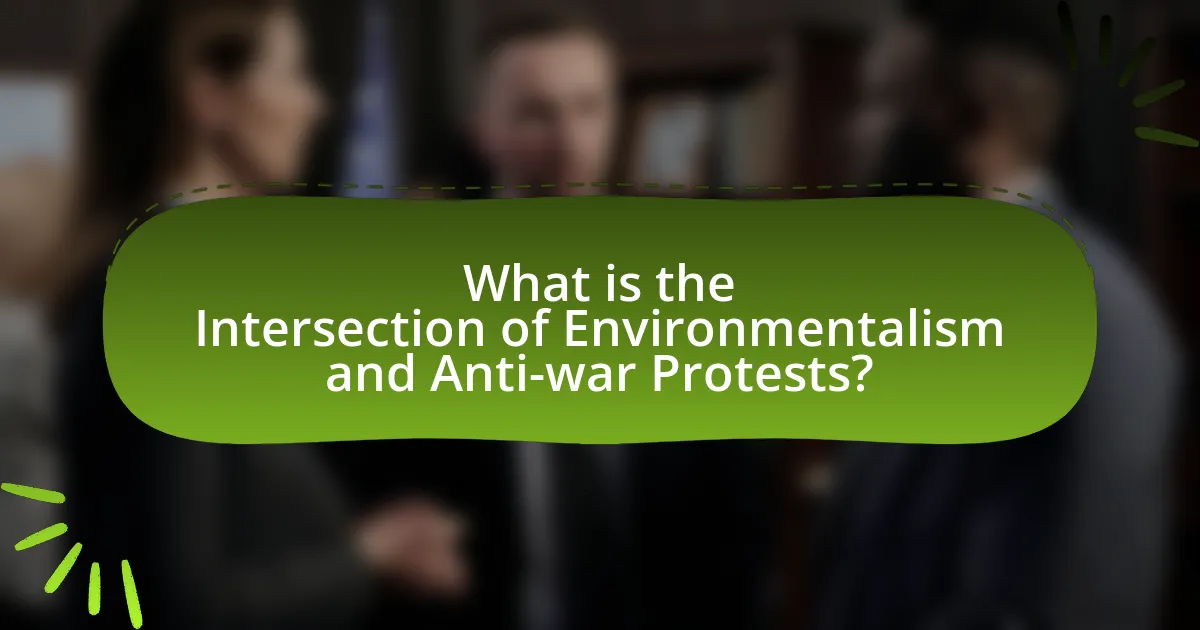
What is the Intersection of Environmentalism and Anti-war Protests?
The intersection of environmentalism and anti-war protests lies in the shared advocacy for peace and sustainability, emphasizing that military actions often lead to environmental degradation. Environmentalists argue that war contributes to pollution, habitat destruction, and climate change, as seen in conflicts that result in oil spills and deforestation. Historical examples include the Vietnam War, where the use of Agent Orange devastated ecosystems, highlighting the environmental costs of military operations. This connection has led to movements that unite both causes, advocating for a peaceful resolution to conflicts while promoting ecological preservation.
How do environmentalism and anti-war movements relate to each other?
Environmentalism and anti-war movements are interconnected through their shared focus on the preservation of life and the opposition to violence that harms both people and the planet. Environmentalists argue that war leads to environmental degradation, as military activities often result in pollution, habitat destruction, and resource depletion. For instance, the U.S. military is one of the largest consumers of fossil fuels and a significant contributor to greenhouse gas emissions, which exacerbates climate change. Conversely, anti-war activists highlight the environmental costs of conflict, advocating for peace as a means to protect ecosystems and promote sustainable practices. This relationship is evident in movements like the Vietnam War protests, where activists linked the destruction caused by war to environmental harm, emphasizing that a peaceful society is essential for ecological health.
What historical events have linked environmentalism and anti-war protests?
The historical events linking environmentalism and anti-war protests include the Vietnam War protests of the 1960s and 1970s, where activists highlighted the environmental destruction caused by military actions, such as defoliation from Agent Orange. Additionally, the 1970 Earth Day celebrations coincided with anti-war demonstrations, uniting activists against both environmental degradation and the war. The 1980s saw the rise of the Green Movement, which often intersected with anti-nuclear protests, emphasizing the environmental risks of nuclear warfare. These events collectively illustrate the intertwined nature of environmentalism and anti-war activism, as both movements advocate for the protection of life and the planet.
How do activists from both movements collaborate?
Activists from both environmental and anti-war movements collaborate through joint campaigns, shared resources, and coordinated events that highlight the interconnectedness of their causes. For instance, they often organize protests that address both environmental degradation and the militarization of resources, emphasizing how war contributes to ecological destruction. Collaborative efforts can include educational workshops, social media campaigns, and coalition-building to amplify their messages, as seen in events like the Global Climate Strike, where anti-war activists participated to advocate for peace alongside environmental justice. This partnership is supported by research indicating that militarization significantly impacts environmental policies and practices, reinforcing the need for a unified approach to both issues.
Why is the intersection of these movements significant?
The intersection of environmentalism and anti-war protests is significant because it highlights the interconnectedness of social justice and ecological sustainability. This relationship emphasizes that militarism contributes to environmental degradation, as military activities often lead to pollution, habitat destruction, and resource depletion. For instance, the U.S. Department of Defense is one of the largest polluters in the world, releasing millions of tons of greenhouse gases annually. By linking these movements, activists advocate for a holistic approach to peace that includes environmental stewardship, thereby fostering a broader understanding of how war impacts both people and the planet. This intersection encourages collaborative efforts to address systemic issues, promoting a more sustainable and just future.
What impact do combined protests have on public awareness?
Combined protests significantly enhance public awareness by uniting diverse social movements, thereby amplifying their messages and reaching broader audiences. When environmental and anti-war protests occur simultaneously, they create a powerful narrative that highlights the interconnectedness of issues such as climate change and militarism. For instance, the 2017 People’s Climate March, which included anti-war activists, drew over 200,000 participants, showcasing how collective action can elevate visibility and urgency around multiple causes. This synergy not only fosters greater media coverage but also encourages public discourse, leading to increased engagement and activism across various demographics.
How do these movements influence policy changes?
Environmentalism and anti-war protests influence policy changes by mobilizing public opinion and pressuring lawmakers to adopt new regulations. These movements often raise awareness about critical issues, such as climate change and military spending, leading to increased public discourse and advocacy. For instance, the anti-Vietnam War protests of the 1960s and 1970s significantly shifted U.S. foreign policy, culminating in the withdrawal of troops. Similarly, the environmental movement has led to landmark legislation, such as the Clean Air Act and the establishment of the Environmental Protection Agency, demonstrating how grassroots activism can result in substantial policy reforms.
What challenges do activists face at this intersection?
Activists at the intersection of environmentalism and anti-war protests face significant challenges, including the difficulty of uniting diverse movements with differing priorities. This fragmentation can lead to competition for resources and attention, making it harder to achieve common goals. Additionally, activists often encounter governmental pushback, as authorities may view both environmental and anti-war activism as threats to the status quo, resulting in increased surveillance and repression. For instance, the FBI has historically monitored environmental and anti-war groups, labeling them as potential domestic terrorists, which creates a climate of fear and discourages participation. Furthermore, activists struggle with public perception, as the urgency of environmental issues may overshadow anti-war sentiments, leading to a lack of support for initiatives that address both concerns simultaneously.
What are the common misconceptions about the relationship between these movements?
Common misconceptions about the relationship between environmentalism and anti-war protests include the belief that these movements are entirely separate and do not influence each other. In reality, both movements often share underlying values, such as a commitment to peace and sustainability. For instance, many anti-war activists argue that militarism contributes to environmental degradation, as military operations can lead to pollution and habitat destruction. Additionally, environmentalists frequently highlight the impact of war on natural resources, asserting that conflicts exacerbate ecological crises. Historical examples, such as the Vietnam War protests, illustrate how anti-war sentiments were intertwined with environmental concerns, as activists raised awareness about the ecological damage caused by chemical warfare.
How do differing priorities affect collaboration?
Differing priorities significantly hinder collaboration by creating misalignment among team members. When individuals or groups prioritize different goals, such as environmental concerns versus anti-war objectives, it leads to conflicting agendas that can stall progress. For instance, a study by the Harvard Business Review found that teams with aligned priorities are 30% more effective in achieving their goals compared to those with divergent priorities. This misalignment can result in wasted resources, decreased morale, and ineffective communication, ultimately undermining the collaborative efforts necessary for addressing complex issues like environmentalism and anti-war activism.
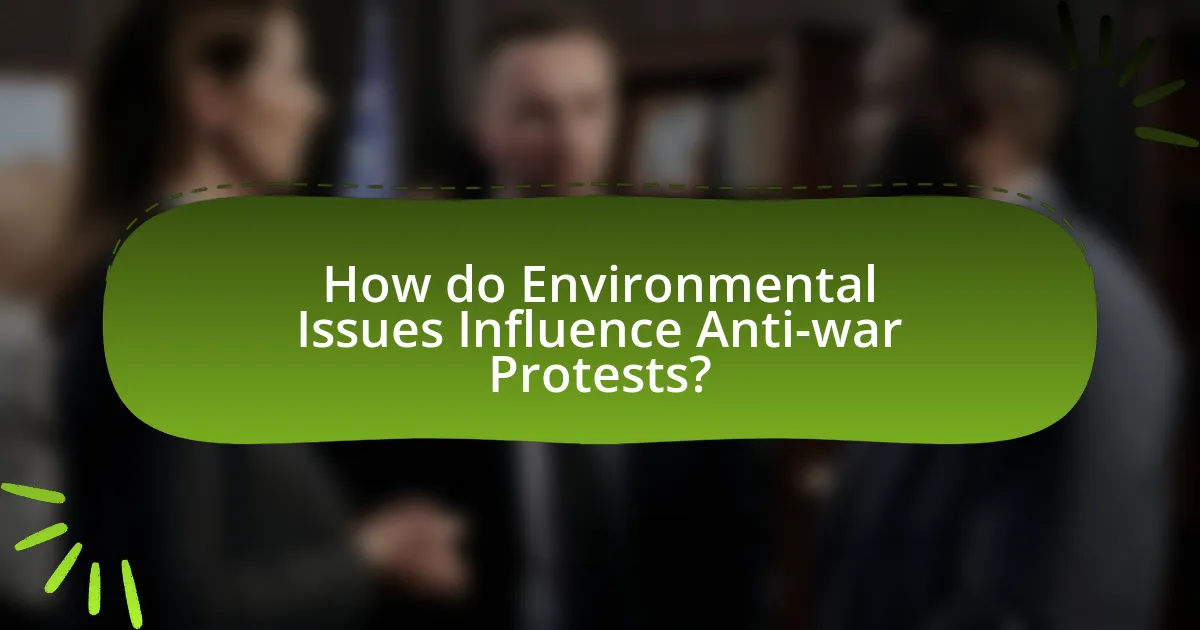
How do Environmental Issues Influence Anti-war Protests?
Environmental issues significantly influence anti-war protests by highlighting the ecological consequences of military actions. Activists argue that war leads to environmental degradation, such as deforestation, pollution, and loss of biodiversity, which exacerbates climate change and threatens public health. For instance, the Vietnam War’s use of Agent Orange resulted in long-lasting ecological damage and health issues for both the environment and local populations. This connection prompts activists to unite environmental and anti-war sentiments, advocating for peace as a means to protect the planet. Consequently, the integration of environmental concerns into anti-war movements mobilizes a broader audience, emphasizing the need for sustainable practices and policies that prioritize both human and ecological well-being.
What environmental concerns are often highlighted in anti-war protests?
Anti-war protests often highlight concerns about the environmental destruction caused by military actions. These concerns include the pollution of air and water, habitat destruction, and the long-term effects of chemical warfare, such as Agent Orange, which has caused significant ecological damage in affected areas. For instance, the U.S. military’s use of depleted uranium in conflicts has raised alarms about soil and water contamination, impacting both ecosystems and human health. Additionally, the military’s carbon footprint is substantial, contributing to climate change, which is increasingly recognized as a critical global issue.
How does military activity impact the environment?
Military activity significantly impacts the environment through habitat destruction, pollution, and resource depletion. Military operations often involve the use of heavy machinery and explosives, which can lead to deforestation, soil degradation, and the disruption of ecosystems. For instance, the U.S. military’s use of live-fire training exercises has been shown to cause significant damage to natural habitats, as evidenced by studies indicating that military training areas often experience higher rates of biodiversity loss compared to non-military lands. Additionally, military activities contribute to air and water pollution through the release of hazardous materials, such as heavy metals and chemicals from munitions, which can contaminate local environments and affect human health. The environmental consequences of military actions are further compounded by the long-term presence of military bases, which can lead to persistent ecological damage and resource strain in surrounding areas.
What role does climate change play in shaping anti-war narratives?
Climate change significantly influences anti-war narratives by highlighting the resource scarcity and geopolitical tensions it creates. As climate change leads to droughts, floods, and other extreme weather events, it exacerbates competition for essential resources like water and arable land, often resulting in conflict. For instance, the Syrian civil war has been partially attributed to severe droughts that displaced millions, illustrating how environmental stress can trigger violence. Additionally, anti-war movements increasingly emphasize the need for global cooperation to address climate issues, framing militarism as a barrier to sustainable solutions. This connection between environmental degradation and conflict shapes public discourse, urging a shift towards peace-oriented policies that prioritize ecological stability.
How do anti-war protests address environmental justice?
Anti-war protests address environmental justice by highlighting the ecological destruction caused by military actions and advocating for a sustainable future. These protests often emphasize the link between war and environmental degradation, such as pollution from military operations, habitat destruction, and the impact of resource extraction in conflict zones. For instance, the U.S. military’s activities have been shown to contribute significantly to carbon emissions, with estimates suggesting that military operations account for approximately 80% of the U.S. government’s carbon footprint. By connecting the dots between militarism and environmental harm, anti-war movements advocate for policies that prioritize peace and ecological sustainability, thereby promoting a holistic approach to justice that encompasses both social and environmental dimensions.
What communities are most affected by both war and environmental degradation?
Communities in conflict zones, particularly in regions like the Middle East, Sub-Saharan Africa, and parts of Southeast Asia, are most affected by both war and environmental degradation. For instance, in Syria, ongoing conflict has led to significant deforestation and soil degradation, exacerbating food insecurity. Similarly, in the Democratic Republic of the Congo, armed conflict has resulted in the destruction of ecosystems and wildlife, while also displacing local populations. These communities face compounded challenges as war disrupts access to resources and environmental degradation diminishes their livelihoods.
How do activists advocate for marginalized voices in these movements?
Activists advocate for marginalized voices in environmentalism and anti-war movements by amplifying their narratives and ensuring representation in decision-making processes. They employ strategies such as grassroots organizing, coalition-building, and utilizing social media platforms to highlight the experiences and needs of marginalized communities. For instance, organizations like the Indigenous Environmental Network focus on the intersectionality of environmental justice and indigenous rights, demonstrating how marginalized groups are disproportionately affected by environmental degradation and militarization. This approach is supported by research indicating that inclusive movements are more effective in addressing systemic issues, as seen in the 2019 Global Climate Strike, where diverse voices were prioritized to advocate for equitable climate solutions.

What Strategies are Effective for Merging Environmentalism and Anti-war Efforts?
Effective strategies for merging environmentalism and anti-war efforts include promoting the concept of militarism’s environmental impact, advocating for sustainable peace initiatives, and fostering coalitions between environmental and peace organizations. Research indicates that military activities contribute significantly to environmental degradation, with studies showing that armed conflicts can lead to deforestation, pollution, and biodiversity loss. By highlighting these connections, activists can create a compelling narrative that emphasizes the need for both environmental protection and peace. Additionally, initiatives like the Green New Deal incorporate elements of both movements, proposing economic reforms that address climate change while reducing military spending. Collaborative campaigns that unite environmental and anti-war groups can amplify their messages, demonstrating that a peaceful world is intrinsically linked to a sustainable environment.
How can activists create a unified message?
Activists can create a unified message by establishing common goals and values that resonate across different movements. This involves identifying shared concerns, such as the impact of war on the environment, and articulating these issues in a way that highlights their interconnectedness. For instance, the anti-war movement can emphasize how military actions contribute to environmental degradation, thereby fostering solidarity with environmental activists. Historical examples, such as the collaboration between environmental groups and peace organizations during the Vietnam War, demonstrate the effectiveness of this approach in mobilizing a broader audience and creating a cohesive narrative. By using clear, consistent language and leveraging social media platforms for widespread dissemination, activists can reinforce their unified message and engage diverse communities in collective action.
What communication strategies resonate with both environmental and anti-war audiences?
Communication strategies that resonate with both environmental and anti-war audiences include emphasizing shared values such as peace, sustainability, and social justice. These audiences often unite around the idea that militarism exacerbates environmental degradation, as evidenced by studies showing that military activities contribute significantly to carbon emissions and resource depletion. For instance, the U.S. military is one of the largest institutional consumers of fossil fuels, which aligns with environmental concerns about climate change. By framing messages that highlight the interconnectedness of environmental protection and anti-war sentiments, such as advocating for disarmament as a means to reduce ecological harm, communicators can effectively engage both groups. This approach fosters a collaborative dialogue that underscores the urgency of addressing both issues simultaneously.
How can social media be leveraged for joint campaigns?
Social media can be leveraged for joint campaigns by facilitating collaboration between environmental and anti-war organizations to amplify their messages and reach wider audiences. By utilizing platforms like Twitter, Facebook, and Instagram, these groups can share resources, coordinate events, and engage supporters through targeted hashtags and campaigns. For instance, the #ClimateStrike movement has successfully united various activist groups, demonstrating how social media can mobilize collective action and raise awareness about interconnected issues such as climate change and militarism. This approach not only enhances visibility but also fosters a sense of community among diverse activist groups, leading to more impactful joint campaigns.
What best practices can be adopted for successful collaboration?
Successful collaboration can be achieved by establishing clear communication, setting shared goals, and fostering mutual respect among participants. Clear communication ensures that all team members understand their roles and responsibilities, which is crucial in collaborative efforts, especially in movements like environmentalism and anti-war protests where diverse perspectives converge. Setting shared goals aligns the group’s efforts and motivates participants, as evidenced by the success of initiatives like the 2019 Global Climate Strike, where unified objectives mobilized millions worldwide. Fostering mutual respect creates an inclusive environment that values each member’s contributions, enhancing creativity and problem-solving, as demonstrated in collaborative projects that integrate environmental and social justice issues.
How can organizations build coalitions between environmental and anti-war groups?
Organizations can build coalitions between environmental and anti-war groups by identifying shared values and goals, such as the impact of militarization on ecological degradation. Collaborative initiatives can be developed around issues like climate change, which is exacerbated by military activities, thereby creating a common platform for advocacy. For instance, the 2019 “Green New Deal” movement highlighted the intersection of environmental justice and anti-war sentiments, emphasizing the need for sustainable policies that also address military spending. This approach fosters mutual understanding and strengthens alliances, as both groups can leverage their networks to amplify their collective voice in policy discussions.
What lessons have been learned from past joint protests?
Past joint protests have demonstrated the importance of solidarity and coalition-building among diverse groups. These protests, such as the 1969 Moratorium to End the War in Vietnam, highlighted that aligning environmental issues with anti-war sentiments can amplify messages and mobilize larger audiences. Research indicates that joint protests can lead to increased visibility and pressure on policymakers, as seen in the 2014 People’s Climate March, which united various social movements. Additionally, lessons learned emphasize the need for clear communication and shared goals to maintain focus and effectiveness during joint actions.
What practical steps can individuals take to support this intersection?
Individuals can support the intersection of environmentalism and anti-war protests by actively participating in both movements, advocating for policies that address climate change while promoting peace. Engaging in local environmental initiatives, such as community clean-ups or tree planting, demonstrates a commitment to ecological health, while joining anti-war demonstrations raises awareness about the environmental impacts of military actions. Research indicates that military operations contribute significantly to carbon emissions, with the U.S. Department of Defense being one of the largest institutional consumers of fossil fuels. By combining efforts in these areas, individuals can effectively highlight the interconnectedness of environmental sustainability and peace, fostering a holistic approach to activism.
How can individuals engage in local activism that addresses both issues?
Individuals can engage in local activism that addresses both environmentalism and anti-war issues by participating in community initiatives that promote sustainability while advocating for peace. For example, organizing or joining local clean-up events can raise awareness about environmental degradation, while simultaneously hosting discussions on how militarization contributes to ecological harm. Research indicates that military activities are significant contributors to carbon emissions, with the U.S. Department of Defense being one of the largest institutional polluters. By linking these two causes, activists can create a unified message that emphasizes the interconnectedness of environmental health and global peace, thereby mobilizing a broader audience for both movements.
What resources are available for those looking to get involved?
Individuals looking to get involved in the intersection of environmentalism and anti-war protests can access various resources, including organizations, online platforms, and community events. Notable organizations such as Greenpeace and the Sierra Club provide opportunities for activism, education, and volunteer work focused on both environmental issues and peace advocacy. Online platforms like Change.org and social media groups facilitate the sharing of petitions and events related to these causes. Additionally, local community centers often host workshops and rallies that encourage participation in both environmental and anti-war initiatives, fostering collaboration among activists.
